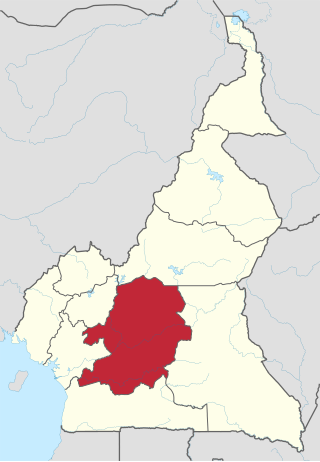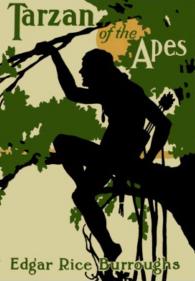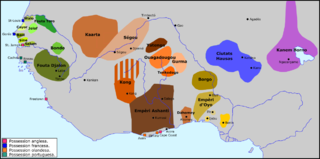
The demographic profile of Cameroon is complex for a country of its population. Cameroon comprises an estimated 250 distinct ethnic groups, which may be formed into five large regional-cultural divisions:

The music of the Cameroon includes diverse traditional and modern musical genres. The best-known contemporary genre is makossa, a popular style that has gained fans across Africa, and its related dance craze bikutsi.
Fang is a Central African language spoken by around 1 million people, most of them in Equatorial Guinea, and northern Gabon, where it is the dominant Bantu language; Fang is also spoken in southern Cameroon, the Republic of the Congo, and small fractions of the islands of São Tomé and Príncipe. It is related to the Bulu and Ewondo languages of southern Cameroon.

The East Region occupies the southeastern portion of the Republic of Cameroon. It is bordered to the east by the Central African Republic, to the south by Congo, to the north by the Adamawa Region, and to the west by the Centre and South Regions. With 109,002 km2 of territory, it is the largest region in the nation as well as the most sparsely populated. Historically, the peoples of the East have been settled in Cameroonian territory for longer than any other of the country's many ethnic groups, the first inhabitants being the Baka pygmies.

The South Region is located in the southwestern and south-central portion of the Republic of Cameroon. It is bordered to the east by the East Region, to the north by the Centre Region, to the northwest by the Littoral Region, to the west by the Gulf of Guinea, and to the south by the countries of Equatorial Guinea, Gabon, and Congo. The South occupies 47,720 km2 of territory, making it the fourth largest region in the nation. The major ethnic groups are the various Beti-Pahuin peoples, such as the Ewondo, Fang, and Bulu.

The Centre Region occupies 69,000 km2 of the central plains of the Republic of Cameroon. It is bordered to the north by the Adamawa Region, to the south by the South Region, to the east by the East Region, and to the West by the Littoral and West Regions. It is the second largest of Cameroon's regions in land area. Major ethnic groups include the Bassa, Ewondo, and Vute.

Tarzan of the Apes is a 1912 story by American writer Edgar Rice Burroughs, and the first in the Tarzan series. It was first printed in the pulp magazine The All-Story in October 1912 before being released as a novel in June 1914.
The Fang-Beti are a Bantu ethnic group located in rain forest regions of Cameroon, Republic of the Congo, Equatorial Guinea, Gabon, and São Tomé and Príncipe. Though they separate themselves into several individual clans, they all share a common origin, history and culture Estimated to be well over 8 million individuals in the early 21st century, they form the largest ethnic group in central Cameroon and its capital city of Yaoundé, in Gabon, and in Equatorial Guinea. Their Beti languages are mutually intelligible.

The Merina people are the largest ethnic group in Madagascar. They are the "highlander" Malagasy ethnic group of the African island and one of the country's eighteen official ethnic groups. Their origins are mixed, predominantly with Austronesians arriving before the 5th century AD, then many centuries later with mostly Bantu Africans, but also some other ethnic groups. They speak the Merina dialect of the official Malagasy language of Madagascar.

The Fang people, also known as Fãn or Pahouin, are a Bantu ethnic group found in Equatorial Guinea, northern Gabon, and southern Cameroon. Representing about 85% of the total population of Equatorial Guinea, concentrated in the Río Muni region, the Fang people are its largest ethnic group. The Fang are also the largest ethnic group in Gabon, making up about a quarter of the population.

Futa Toro, often simply the Futa, is a semidesert region around the middle run of the Senegal River. This region is along the border of Senegal and Mauritania. It is well watered and fertile close to the river, but the interior parts of the region away from the river is porous, dry and infertile. This region is historically significant for the Islamic states, Fulani states, jihad armies and migrants for Fouta Djallon that emerged from here.

The Banda people are an ethnic group of the Central African Republic. They are likewise found in the Democratic Republic of the Congo, Cameroon, and South Sudan. They were severely affected by slave raids of the 19th century and slave trading out of Africa. Under French colonial rule, most converted to Christianity but retained elements of their traditional religious systems and values.
Bulu is a Bantu language of the Bulu people of Cameroon. The language had 174,000 native speakers in 1982, with some 800,000 second language speakers in 1991. Its dialects include Bene, Yelinda, Yembana, Yengono, and Zaman. Bulu was formerly used by colonial and missionary groups as a lingua franca in the region for commercial, educational, and religious purposes, though it is today becoming less frequent in those spheres.
Caste systems in Africa are a form of social stratification found in numerous ethnic groups, found in over fifteen countries, particularly in the Sahel, West Africa, and North Africa. These caste systems feature endogamy, hierarchical status, inherited occupation, membership by birth, pollution concepts and restraints on commensality.
Ewondo or Beti is the language of the Fang-Beti people of Cameroon. The language had 577,700 native speakers in 1982. Ewondo is a trade language. Dialects include Badjia (Bakjo), Bafeuk, Bemvele, Bane, Beti, Enoah, Evouzok, Fong, Mbida-Bani, Mvete, Mvog-Niengue, Omvang, Yabekolo (Yebekolo), Yabeka, and Yabekanga. Ewondo speakers live primarily in Cameroon's Centre Region and the northern part of the Océan division in the South Region.
Beti is a group of Bantu languages, spoken by the Beti-Pahuin peoples who inhabit the rain forest regions of Cameroon, Republic of the Congo, Equatorial Guinea, Gabon, and São Tomé and Príncipe. The varieties, which are largely mutually intelligible and variously considered dialects or closely related languages, are:

Tarzan is a fictional character, a feral child raised in the African jungle by the Mangani great apes; he later experiences civilization, only to reject it and return to the wild as a heroic adventurer.
Akwa Boni, was a sovereign Queen of the Baoulé people. The niece of Queen Pokou, she inherited the throne in around 1760 and ruled until her death in about 1790. She expanded the territory of the Baoulé, crossing the Bandama River and into the central Ivory Coast. In order to cross the river, one story has it that she needed to sacrifice her son to the river god; in doing so she gave her people their name, bauli, meaning 'the son is dead'.

Chikwangue, also known in Cameroon as bobolo and in the Congo River basin language of Lingala as kwanga, is a starchy, fermented-cassava product that is a staple food across Central Africa: the Democratic Republic of Congo (DRC), the Republic of Congo (RotC), Gabon, Cameroon and Equatorial Guinea. Chikwangue is made by fermenting cassava in water for up to fourteen days, then turning it into a paste and wrapping it in marantaceae leaves for steaming.














